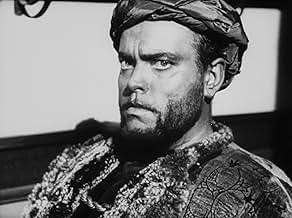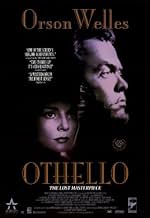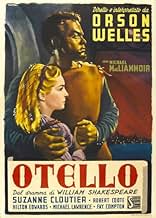ÉVALUATION IMDb
7,5/10
9,7 k
MA NOTE
Ajouter une intrigue dans votre langueThe Moorish General Othello is manipulated into thinking that his new wife Desdemona has been carrying on an affair with his Lieutenant Michael Cassio when in reality, it is all part of the ... Tout lireThe Moorish General Othello is manipulated into thinking that his new wife Desdemona has been carrying on an affair with his Lieutenant Michael Cassio when in reality, it is all part of the scheme of a bitter Ensign named Iago.The Moorish General Othello is manipulated into thinking that his new wife Desdemona has been carrying on an affair with his Lieutenant Michael Cassio when in reality, it is all part of the scheme of a bitter Ensign named Iago.
- Prix
- 1 victoire et 1 nomination au total
Abdullah Ben Mohamet
- Pageboy
- (uncredited)
Joseph Cotten
- Senator
- (uncredited)
Jean Davis
- Montano
- (uncredited)
Joan Fontaine
- Page
- (uncredited)
Robert Rietty
- Lodovico
- (voice)
- (uncredited)
Gudrun Ure
- Desdemona
- (voice)
- (uncredited)
Histoire
Le saviez-vous
- AnecdotesThe movie was shot over three years and production was stopped twice, mainly because Welles ran out of money. He then starred in the films "Le troisième homme (1949)" and "Prince of Foxes (1949)." He took his payment from those films and used them as money for "Othello".
- Autres versionsThis film by Orson Welles, was 'restored' by a group in Chicago in 1991/2. The film was transferred to, and enhanced in video, (D1 format) retaining it as black and white. The audio was completely rebuilt, including the score, in Stereo Surround. All dialogue, however was original. This was a problem as some of the dialogue was distorted and unintelligible. John Fogelson, editor, was a major supervisor of the project. Ed Golya, Lorita DeLacerna, and Steve Wilke, were digital editors. And Ed Golya remixed the soundtrack. The process took 9 months. It was purchased for distribution by Castle Hill, and taken to New York where it went through another transformation before release. The restoration engineer in New York, Paul Michael, restored the audio that was supplied on 35mm optical negatives. He was able to remove the distortion, optical pops and surface noise that is inherent with Optical negatives. The restored audio was then sent to Sound One for the final mix. Unintelligible dialogue was replaced with 'sound-alikes'. This decision was made for the entertainment value of the film. The original mono music was then reintroduced into the final product. Basically, the film was retransferred, and the rebuilt sound effects tracks were added. This was done at Sound One, in NYC.. The credits were adjusted to place Lee Dickter (sp?) as Re-recording Mixer, and Ed Golya as Sound Effects Editor.
- ConnexionsEdited into Histoire(s) du cinéma: La monnaie de l'absolu (1999)
Commentaire en vedette
Othello, Moor of Venice, loves Desdemonda. Unbeknownst to him, one of his lieutenants, Iago, seething with jealousy, plans to bring him down. Iago slowly builds a web of deceit and lies around Othello that leads him to question the faithfulness of his wife and men, ultimately pushing him to far...
Many a time has a white actor portrayed black Othello. Thankfully, Welles excels in the title role, his hurt palpable. In adapting Shakespeare's play, Welles has done away with subplots he deemed unnecessary. His "Othello" boils down to the title character, his wife, Iago and bit players (and impressive numbers of extras). Fans of the text may regret the absence of a character or the significant reduction of his/her importance. It diminishes the play but enhances the film, giving it a tighter focus and a more fluid structure and running time. But as always, we expect more from an Orson Welles film.
Orson Welles is mostly celebrated for reinventing the look of film. His pictures each possess a unique aesthetic and daring camera work. Othello holds its own even when measured against the impressive Welles oeuvre, a true miracle if you are familiar with the films' history. Shooting it over years and in different locations (Morocco, Spain, etc.) with variations, often within the same scene, Welles managed to create the watertight illusion of a coherent world, leading the viewer to imagine that lavish sets and locations were available. For anyone interested in editing or any other aspect of film-making, this is an indisputable milestone in directorial resourcefulness.
Othello was Welles's second Shakespeare interpretation as star and director, soaring high above his very interesting Macbeth. He would return to the Bard one last time with his apotheosis, Chimes at Midnight. This trilogy is a gift. What a joy it is to see America's greatest director work with the world's greatest playwright...
Many a time has a white actor portrayed black Othello. Thankfully, Welles excels in the title role, his hurt palpable. In adapting Shakespeare's play, Welles has done away with subplots he deemed unnecessary. His "Othello" boils down to the title character, his wife, Iago and bit players (and impressive numbers of extras). Fans of the text may regret the absence of a character or the significant reduction of his/her importance. It diminishes the play but enhances the film, giving it a tighter focus and a more fluid structure and running time. But as always, we expect more from an Orson Welles film.
Orson Welles is mostly celebrated for reinventing the look of film. His pictures each possess a unique aesthetic and daring camera work. Othello holds its own even when measured against the impressive Welles oeuvre, a true miracle if you are familiar with the films' history. Shooting it over years and in different locations (Morocco, Spain, etc.) with variations, often within the same scene, Welles managed to create the watertight illusion of a coherent world, leading the viewer to imagine that lavish sets and locations were available. For anyone interested in editing or any other aspect of film-making, this is an indisputable milestone in directorial resourcefulness.
Othello was Welles's second Shakespeare interpretation as star and director, soaring high above his very interesting Macbeth. He would return to the Bard one last time with his apotheosis, Chimes at Midnight. This trilogy is a gift. What a joy it is to see America's greatest director work with the world's greatest playwright...
- OttoVonB
- 1 août 2006
- Lien permanent
Meilleurs choix
Connectez-vous pour évaluer et surveiller les recommandations personnalisées
- How long is Othello?Propulsé par Alexa
Détails
- Date de sortie
- Pays d’origine
- Sites officiels
- Langues
- Aussi connu sous le nom de
- Othello
- Lieux de tournage
- Castle, El Jadida, Morocco(cistern interior)
- sociétés de production
- Consultez plus de crédits d'entreprise sur IMDbPro
Box-office
- Brut – États-Unis et Canada
- 28 980 $ US
- Fin de semaine d'ouverture – États-Unis et Canada
- 6 010 $ US
- 27 avr. 2014
- Brut – à l'échelle mondiale
- 28 980 $ US
- Durée1 heure 30 minutes
- Couleur
- Rapport de forme
- 1.37 : 1
Contribuer à cette page
Suggérer une modification ou ajouter du contenu manquant

Lacune principale
By what name was The Tragedy of Othello: The Moor of Venice (1951) officially released in India in English?
Répondre





















